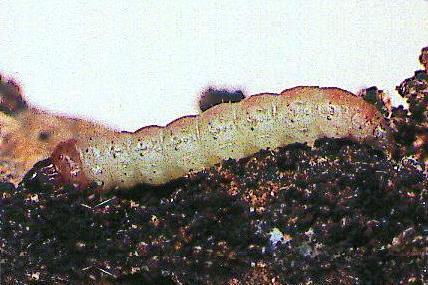
(Specimen: courtesy of the
Queensland Department of Primary Industry,
Bundaberg, Queensland)
This Caterpillar is off-white, with a narrow dark brown
thorax, and
an even narrower dark brown head.
It is an agricultural pest.
It bores into the leaves, shoots and stems of the plants,
as well as root tubers, of members of the family
SOLANACEAE, including:
Potato ( Solanum tuberosum ),
Tomato ( Lycopersicum esculentum ),
Tobacco ( Nicotiana tabacum ), and
Eggplant ( Solanum melongena ).
The caterpillar grows to a length of about 1 cm.
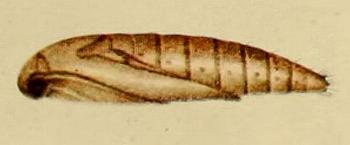
pupa, drawing by Harold Maxwell-Lefroy,
Indian Insect Life: a Manual of the Insects of the Plains, 1909, Plate LVII, fig. 10,
image courtesy of Biodiversity Heritage Library,
digitized by NCSU Libraries.
The caterpillar often pupates in a damaged tuber.
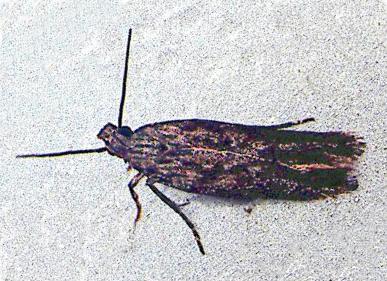
(Specimen: courtesy of the
Queensland Department of Primary Industry,
Bundaberg, Queensland)
The adult moths have wings with a complex brown pattern
including 4 dark spots.
The moths have a wingspan of about 1 cm.
The pheromones of
this species have been identified.
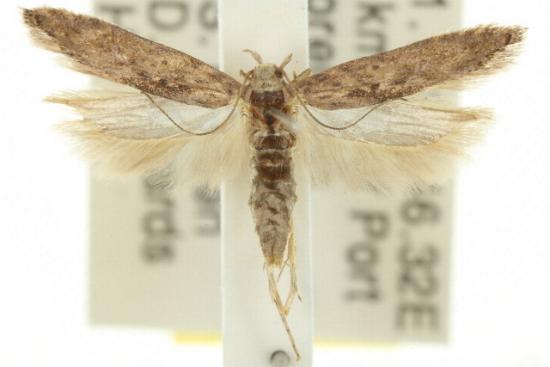
(Photo: courtesy of CSIRO/BIO Photography Group,
Centre for Biodiversity Genomics,
University of Guelph)
The eggs are round and off-white.
They are laid in groups typically on the eye of a potato.
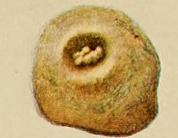
eggs, drawing by Harold Maxwell-Lefroy,
Indian Insect Life: a Manual of the Insects of the Plains, 1909, Plate LVII, fig. 12,
image courtesy of Biodiversity Heritage Library,
digitized by NCSU Libraries.
The species occurs world-wide , for example
Hawaii,
India,
Japan,
New Zealand,
Peru,
Russia, and
USA.
It was introduced by unfortunate accident into Australia,
and now has been found in
Western Australia,
Northern Territory,
Queensland,
New South Wales,
Australian Capital Territory,
Victoria,
Tasmania, and
South Australia.
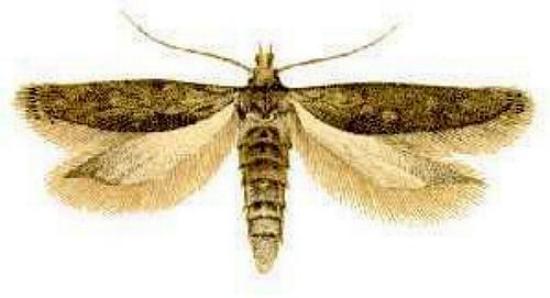
(Picture: courtesy of the
CSIRO Ecosystem Sciences)
The species may be controlled by
irradiation to generate a lethal strain,
using
insecticides,
the
PoGV Granulosis Virus (
BACULOVIRIDAE ),
the bacterium
Bacillus thuringiensis (
BACILLACEAE ),
the wasp
Orgilus lepidus (
BRACONIDAE ),
the wasp
Apanteles subandinus (
BRACONIDAE ),
the egg parasitoid wasp
Trichogramma pretiosum (
TRICHOGRAMMATIDAE ), and
the egg parasitoid wasp
Copidosoma koehleri (
ENCYRTIDAE ).
Further reading :
Ian F.B. Common,
Moths of Australia,
Melbourne University Press, 1990, fig. 25.13, pp. 57-58, 62, 68, 260.
Peter B. McQuillan, Jan A. Forrest, David Keane, & Roger Grund,
Caterpillars, moths, and their plants of Southern Australia,
Butterfly Conservation South Australia Inc., Adelaide (2019), p. 57.
Philipp C. Zeller,
Beiträge zur Kenntniss der Nordamerikanischen Nachtfälter, besonders der Microlepidopteren 2,
Verhandlungen der Zoologisch-Botanischen Gesellschaft in Wien,
Band 23 (1873), pp. 262-264,, and also
Plate 3, fig. 17.
(updated 17 December 2008, 16 September2025)











